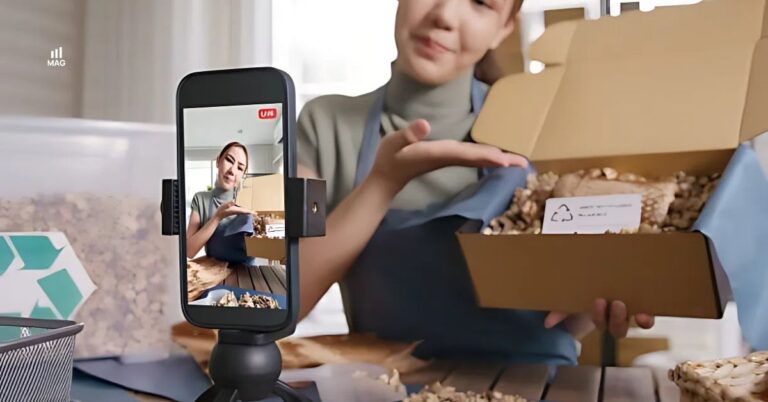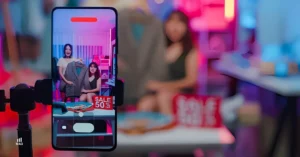
Live social shopping is rising, driven by Gen Z and Millennial shoppers who make purchases directly through social platforms.
Live Social Shopping is rising, fundamentally changing the landscape of e-commerce. This innovative sales channel, where brands directly engage with consumers through live video streams, first took root in China with trailblazers like Taobao leading the charge in 2016.
The results speak for themselves: Chinese brands leveraging this strategy boast an extraordinary 30% conversion rate on social media. Now, this phenomenon is rapidly expanding beyond its origins, gaining significant momentum worldwide, especially in Western markets.
The question for Amazon and e-commerce sellers is clear: are you prepared to harness the power of this burgeoning retail trend to help boost your sales?
Live social shopping, the biggest trend in the West?
The landscape of Western e-commerce is on the cusp of a dramatic transformation, driven by the escalating popularity of live social shopping experience.
An article on Brand Innovators featured that the CEO of VaynerMedia, Gary Vaynerchuk, identifies “the largest trend in the West” as the rise of live social shopping. He emphasizes its profound potential to reshape entire careers for those in the e-commerce space.
Vaynerchuk strongly encourages individuals to dedicate significant time to understanding this burgeoning trend, specifically researching live social shopping and platforms like TikTok Shop. He advises focusing on the origins and success of live shopping in China and its implications for European and U.S. markets, highlighting its enormous potential.
To underscore the impact of this phenomenon, Vaynerchuk shared a compelling personal anecdote.
While building a side project, VeeFriends, he conducted a two-hour livestream on the platform Whatnot, generating an impressive $140,000 in revenue. He contrasted this with a typical social media execution, which he estimated would yield only around $7,000 for the same product, demonstrating the unique power of live interaction.
Vaynerchuk positions social selling not merely as a transaction but as a form of entertainment, crucial for building community and engagement. He believes that integrating entertainment and commerce allows brands to forge deeper connections with their audience.
Looking ahead, Vaynerchuk also predicts a future where AI influencers will become prevalent, with brands creating their own digital personalities to connect with consumers, potentially reducing reliance on traditional human influencers.
Vaynerchuk strongly encourages individuals to dedicate significant time to understanding this burgeoning trend, specifically researching live social shopping and platforms like TikTok Shop. He advises focusing on the origins and success of live shopping in China and its implications for European and U.S. markets, highlighting its enormous potential.
In his LinkedIn post, Vaynerchuk referred to the trend as the “QVC-ification” of social media and encouraged readers to dedicate at least five hours to researching it. He emphasized that those who take the initiative to understand this shift will be better positioned to succeed in an increasingly social and interactive online retail environment.
Forbes"Live commerce is transforming this landscape by offering a highly engaging shopping experience that dramatically boosts conversion rates."
Global surge in live social shopping driven by digital innovation
The acceleration of e-commerce has been shaped by changing consumer habits and rapid tech adoption. Among the standout trends are live commerce and social commerce, both redefining how products are marketed and sold online.
Live commerce uses real-time video content on digital platforms to promote and sell products, creating a two-way interaction unlike traditional home shopping formats. This digital-first approach enables immediate engagement and transactions, appealing to a generation of shoppers who expect both convenience and entertainment.
According to a published article on Statista, China leads the world in live commerce adoption, with its market reaching nearly five trillion yuan in 2023 – a twelvefold increase since the start of the COVID-19 pandemic. This success has inspired global retailers and platforms to adopt similar models, particularly in emerging markets.
Southeast Asian countries like Indonesia, Thailand, and India have also embraced livestream shopping, driven by mobile-first internet usage and social media engagement. Meanwhile, Brazil is leading Latin America’s adoption of live commerce, and the United States is on track to reach nearly 50 million livestream shoppers by 2025, with projections exceeding 60 million by 2028.
In the West, social media platforms are at the forefront of this shift. Consumers are increasingly shopping through livestreams on TikTok, Facebook, and Douyin, with TikTok ranking as the most-used live commerce platform in Southeast Asia in 2024.
Live shopping content is also becoming central to influencer marketing strategies worldwide. In 2025, it was ranked as the top-performing format for brand collaborations, reflecting how commerce and content continue to merge.
Livestream shopping is no longer a niche – it’s a growing force in global digital retail. As more brands explore this space, the lines between entertainment, community, and commerce continue to blur.
Social commerce redefining retail for the next generation
Social commerce is rapidly emerging as a transformative force in the retail industry, mirroring the seismic shift e-commerce brought to Millennials, now impacting Gen Z and even Gen Alpha.
According to Exploding Topics, a significant proportion of young consumers are already integrating social media directly into their purchasing habits. In the United States, 34% of consumers aged 18-34 are making weekly purchases directly through social media platforms, often leading to seamless purchases within their social feeds, particularly on TikTok.
The mechanics behind live social shopping's rapid rise
Executing a successful live shopping event to make viewers make a purchase requires meticulous planning across several key phases, ensuring maximum engagement and sales. These events typically occur on social media platforms like TikTok, YouTube, or Instagram, or through specialized live shopping platforms. Sprout Social explained how live social shopping drives results for brands by breaking down the essential steps involved.
Before the event
The preparatory stage involves selecting the featured products and choosing a suitable live stream shopping platform, many of which facilitate in-stream purchases through features like QR codes and in-app checkout. Identifying the right host is paramount, as they need to be energetic, camera-ready, product-savvy, and resilient to potential on-air challenges.
While a brand representative can host, collaborating with an influencer can significantly expand reach and build consumer trust. Businesses, perhaps with the guidance of an Amazon agency, should promote the event across primary marketing channels and consider offering exclusive products or discounts to generate excitement.
Finally, preparing a clean set, ensuring excellent lighting, audio, and video quality, and rehearsing talking points are crucial to convince viewers to buy products.
During the event
When the event goes live, the host’s role is to dynamically demonstrate products, answer viewer questions, and foster interaction. It is advisable to have a team on standby to monitor the chat and resolve any technical glitches that may arise.
To maintain high energy and prevent the event from feeling like a one-sided sales pitch, incorporating interactive elements such as polls, contests, and giveaways can be highly effective. Concluding the session with a final call to action, perhaps an exclusive post-event deal for live viewers, can further drive conversions.
After the event
Post-event activities are critical for sustained success and include reviewing key metrics like views, engagement, and sales to assess performance and identify areas for improvement in future live shopping endeavors.
Continued engagement with attendees is also vital, involving follow-up messages or emails, addressing missed questions, and sharing exclusive deals or resources to maintain interest.
Repurposing the livestream recording for social media content can also generate FOMO (fear of missing out) and encourage participation in upcoming events.
Navigating live social shopping platforms
The choice of platform is as significant as the products being sold, as different options offer unique tools, audiences, and selling experiences.
Live shopping platform options include:
Social networks with live shopping functions
TikTok and YouTube allow in-stream purchases. Instagram has shopping integration, but Facebook and X don’t support full live shopping features.
Social networks with live shopping functions
Apps like TalkShopLive, Whatnot, and Buywith offer full control and focused audiences but lack social virality.
Self-hosted platforms
Custom solutions like 1916 Live offer full branding control but require more setup and user acquisition efforts.
Savings.com"TikTok dominates consumer engagement: 29% of American adults have viewed TikTok Live for shopping."
Emerging livestream shopping trends
Creating an immersive experience is central to modern livestream shopping, with several trends keeping shoppers engaged.
Themed promotions
Events tied to holidays or product launches drive urgency and excitement.
Influencer collaborations
Partnering with creators deepens engagement and widens reach.
Entertainment + Commerce
Hosts who bring personality and creativity can turn product demos into events viewers don’t want to miss.






